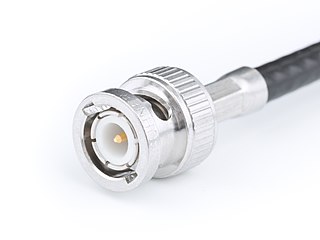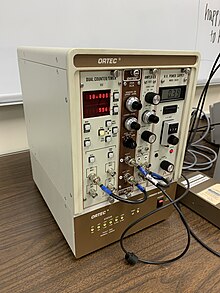
A backplane is a group of electrical connectors in parallel with each other, so that each pin of each connector is linked to the same relative pin of all the other connectors, forming a computer bus. It is used to connect several printed circuit boards together to make up a complete computer system. Backplanes commonly use a printed circuit board, but wire-wrapped backplanes have also been used in minicomputers and high-reliability applications.

Eurocard is an IEEE standard format for printed circuit board (PCB) cards that can be plugged together into a standard chassis which, in turn, can be mounted in a 19-inch rack. The chassis consists of a series of slotted card guides on the top and bottom, into which the cards are slid so they stand on end, like books on a shelf. At the spine of each card is one or more connectors which plug into mating connectors on a backplane that closes the rear of the chassis.

Coaxial cable, or coax is a type of electrical cable consisting of an inner conductor surrounded by a concentric conducting shield, with the two separated by a dielectric ; many coaxial cables also have a protective outer sheath or jacket. The term coaxial refers to the inner conductor and the outer shield sharing a geometric axis.

The BNC connector is a miniature quick connect/disconnect radio frequency connector used for coaxial cable. It is designed to maintain the same characteristic impedance of the cable, with 50 ohm and 75 ohm types being made. It is usually applied for video and radio frequency connections up to about 2 GHz and up to 500 volts. The connector has a twist to lock design with two lugs in the female portion of the connector engaging a slot in the shell of the male portion. The type was introduced on military radio equipment in the 1940s and has since become widely applied in radio systems, and is a common type of video connector. Similar radio-frequency connectors differ in dimensions and attachment features, and may allow for higher voltages, higher frequencies, or three-wire connections.

VMEbus is a computer bus standard, originally developed for the Motorola 68000 line of CPUs, but later widely used for many applications and standardized by the IEC as ANSI/IEEE 1014-1987. It is physically based on Eurocard sizes, mechanicals and connectors, but uses its own signalling system, which Eurocard does not define. It was first developed in 1981 and continues to see widespread use today.
Futurebus, or IEEE 896, is a computer bus standard, intended to replace all local bus connections in a computer, including the CPU, memory, plug-in cards and even, to some extent, LAN links between machines. The effort started in 1979 and didn't complete until 1987, and then immediately went into a redesign that lasted until 1994. By this point, implementation of a chip-set based on the standard lacked industry leadership. It has seen little real-world use, although custom implementations continue to be designed and used throughout industry.

Data acquisition is the process of sampling signals that measure real-world physical conditions and converting the resulting samples into digital numeric values that can be manipulated by a computer. Data acquisition systems, abbreviated by the acronyms DAS,DAQ, or DAU, typically convert analog waveforms into digital values for processing. The components of data acquisition systems include:
A Digital Signal 3 (DS3) is a digital signal level 3 T-carrier. It may also be referred to as a T3 line.

Thomas Jefferson National Accelerator Facility (TJNAF), commonly called Jefferson Lab or JLab, is a US National Laboratory located in Newport News, Virginia. Its stated mission is "to provide forefront scientific facilities, opportunities and leadership essential for discovering the fundamental structure of nuclear matter; to partner in industry to apply its advanced technology; and to serve the nation and its communities through education and public outreach."

The STEbus is a non-proprietary, processor-independent, computer bus with 8 data lines and 20 address lines. It was popular for industrial control systems in the late 1980s and early 1990s before the ubiquitous IBM PC dominated this market. STE stands for STandard Eurocard.

Computer-Aided Measurement And Control (CAMAC) is a standard bus and modular-crate electronics standard for data acquisition and control used in particle detectors for nuclear and particle physics and in industry. The bus allows data exchange between plug-in modules and a crate controller, which then interfaces to a PC or to a VME-CAMAC interface.

RG-6/U is a common type of coaxial cable used in a wide variety of residential and commercial applications. An RG-6/U coaxial cable has a characteristic impedance of 75 ohms. The term, RG-6, is generic and is applied to a wide variety of cable designs, which differ from one another in shielding characteristics, center conductor composition, dielectric type and jacket type. RG was originally a unit indicator for bulk radio frequency (RF) cable in the U.S. military's Joint Electronics Type Designation System. The suffix /U means for general utility use. The number was assigned sequentially. The RG unit indicator is no longer part of the JETDS system (MIL-STD-196E) and cable sold today under the RG-6 label is unlikely to meet military specifications. In practice, the term RG-6 is generally used to refer to coaxial cables with an 18 AWG center conductor and 75 ohm characteristic impedance.

VPX, also known as VITA 46, refers to a set of standards for connecting components of a computer, commonly used by defense contractors. Some are ANSI standards such as ANSI/VITA 46.0–2019. VPX provides VMEbus-based systems with support for switched fabrics over a new high speed connector. Defined by the VMEbus International Trade Association (VITA) working group starting in 2003, it was first demonstrated in 2004, and became an ANSI standard in 2007.
M-Modules are a mezzanine standard mainly used in industrial computers. Being mezzanines, they are always plugged on a carrier printed circuit board (PCB) that supports this format. The modules communicate with their carrier over a dedicated bus, and can have all kinds of special functions.
FASTBUS is a computer bus standard, originally intended to replace Computer Automated Measurement and Control (CAMAC) in high-speed, large-scale data acquisition. It is also a modular crate electronics standard commonly used in data acquisition systems in particle detectors.

In electronics, an antenna amplifier is a device that amplifies an antenna signal, usually into an output with the same impedance as the input impedance. Typically 75 ohm for coaxial cable and 300 ohm for twin-lead cable.

FPGA Mezzanine Card (FMC) is an ANSI/VITA 57.1 standard that defines I/O mezzanine modules with connection to an FPGA or other device with re-configurable I/O capability. It specifies a low profile connector and compact board size for compatibility with several industry standard slot card, blade, low profile motherboard, and mezzanine form factors.

Modular crate electronics are a general type of electronics and support infrastructure commonly used for trigger electronics and data acquisition in particle detectors. These types of electronics are common in such detectors because all the electronic pathways are made by discrete physical cables connecting together logic blocks on the fronts of modules. This allows circuits to be designed, built, tested, and deployed very quickly as an experiment is being put together. Then the modules can all be removed and used again when the experiment is done.
MicroTCA is a modular, open standard, created and maintained by the PCI Industrial Computer Manufacturers Group (PICMG). It provides the electrical, mechanical, thermal and management specifications to create a switched fabric computer system, using Advanced Mezzanine Cards (AMC), connected directly to a backplane. MicroTCA is a descendant of the AdvancedTCA standard.
Wi-Fi over Coax is a technology for extending and distributing Wi-Fi signals via coaxial cables. As an in-building wireless solution, Wi-Fi over Coax can make use of existing or new cabling with native impedance of 50 Ω shared by a Wi-Fi access point, cabling run, and antenna. Coaxial cables with characteristic impedance of 75 Ω, such as RG-6 cables used for in-building television distribution, can also be used by incorporating impedance converters. As part of a distributed antenna system, Wi-Fi over Coax can connect multiple floors of a home or office via power dividers and zoned antennas either passively or via amplifiers, potentially eliminating the need for multiple access points.













